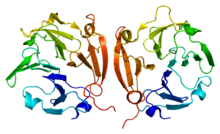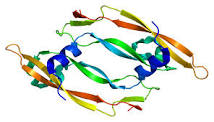Angiogenesis Inhibitor in Cancer
Angiogenesis inhibitors can inhibit the formation of blood vessels with a variety of factors as targets. These factors include: MMP (Figure 1), various growth factors or growth factor receptors, endothelial cells, and so on. Traditional anticancer drugs used in chemotherapy can also be used to inhibit angiogenesis as long as appropriate treatment options are developed. The side effects of anti-angiogenic drugs are much less than those of chemotherapy drugs. However, most drugs need to be used in conjunction with other therapies to ensure a complete cure of the tumor.
 Figure 1. The hemopexin-like C-terminal domain of MMP9 PDB 1itv.
Figure 1. The hemopexin-like C-terminal domain of MMP9 PDB 1itv.
Functions
The side effects of angiogenesis inhibitors are much smaller compared to traditional chemotherapeutic drugs because the cytotoxicity of the former is much smaller. However, patients need to take these drugs for a long time. The side effects caused by angiogenesis inhibitor drug therapy require a high degree of attention. Since angiogenesis inhibitors can impede the formation of new blood vessels, patients who are treated with such drugs may develop infections due to wound healing problems if wounds are present. It is also for this reason that pregnant women cannot use the drug because it can destroy the formation of fetal blood vessels.
In addition, prolonged use of such drugs can cause problems such as blood clots, high or low blood pressure. Although experimental data from animal models (usually mice) indicate that the drug has a very bright application prospect, the results of relevant clinical trials are mostly disappointing. The drug treatment did not show an inhibitory effect on the tumor, and did not even reduce the growth rate of the tumor. The main reason for this result is the large number of angiogenic factors. In early tumors, only one or two growth factors are secreted, so only one inhibitor can be used to achieve efficacy. However, tumors in advanced stage produce a variety of factors, and it is obviously not enough to treat only one type of inhibitors for such tumors. Therefore, for advanced tumors, a single angiogenesis inhibitor may not achieve the desired effect.
General side effects of drugs
Bleeding
Bleeding is one of the most difficult side effects of treating this complication and is inherently intrinsic to the efficacy of the drug. Bevacizumab has proven to be the drug most likely to cause bleeding complications. Although the mechanism of bleeding caused by anti-VEGF drugs is complex, it is not fully understood, but the most widely accepted hypothesis is that VEGF can promote the survival and integrity of endothelial cells in the adult vasculature, and its inhibition may reduce the damaged endothelium. Cell renewal ability.
 Figure 2. Structure of VEGF.
Figure 2. Structure of VEGF.
High blood pressure
A study by ML Maitland showed an average blood pressure increase of 8.2 mm Hg systolic blood pressure and 6.5 mm Hg diastolic blood pressure during the first 24 hours after the first treatment with the VEGF pathway inhibitor sorafenib.
Less common side effects
Since these drugs act on certain parts of blood vessels, they tend to have side effects that affect these processes. In addition to bleeding and high blood pressure problems, the less common side effects of these drugs include dry skin, itching, hand-foot syndrome (tender, thickened areas of the skin, sometimes blisters on the palms and feet), diarrhea, fatigue and low blood counts. Angiogenesis inhibitors can also interfere with wound healing and cause the incision to reopen or bleed. Rarely perforated in the intestine
References:
1. Gardlik, R.; et al. Gene therapy for cancer: bacteria-mediated anti-angiogenesis therapy. Gene therapy. 2011,18(5), 425-431.
2. Xu, Y. F.; et al. A new expression plasmid in Bifidobacterium longum as a delivery system of endostatin for cancer gene therapy. Cancer gene therapy. 2007, 14(2), 151-157.
2. Nyberg P.; et al. Endogenous inhibitors of angiogenesis. Cancer Research. 2005, 165 (10): 3967–79.


